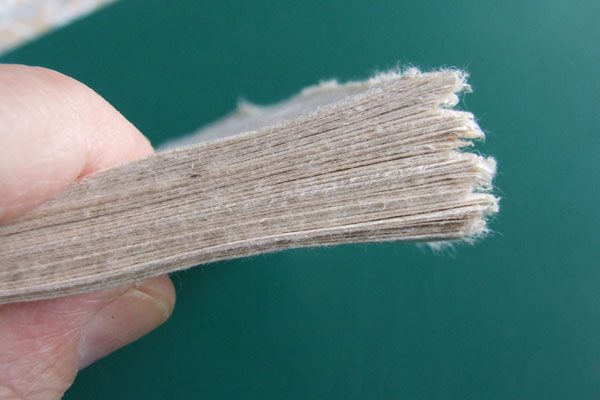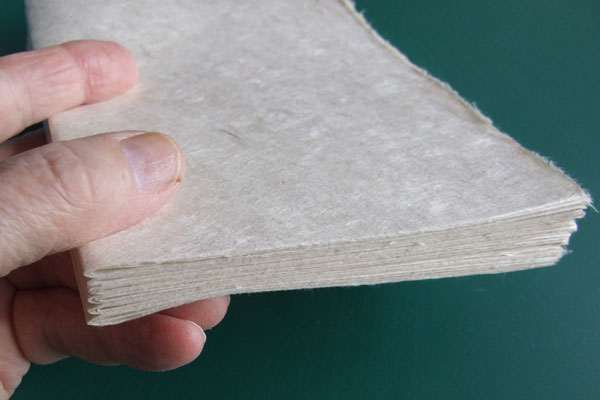
The deckle edges of a bundle of Hatakami Papers
Nepalese handmade papers tend ~ generically ~ to be called lokta. Hatakami is a soft but strong and smooth high quality variant. Hatakami uses a blend of two natural fibres native to Nepal. The shrubby strength of sethbarau (mulberry ~ kozo ~ widely used also in China and Japan) is combined with argeli (mistumata ~ a softer plant widely also used for making papers in the Far East).
The paper we are discussing here ~ and is on sale in our shop ~ is made at a small mill in Nepal. We are able to buy the papers direct from the mill ~ which is run by a very philanthropic young family [126985].


Hatakami is the name for this type of lokta paper ~ prakrtika means natural. The plants from which the fibres are obtained recover after harvesting ~ and regrow sufficiently for re-use in a few years ~ natural sustainability. Some of these fibres are only suitable for papermaking in particular seasons of the year, and the fibres do not store well.
The required plants only grow at altitudes and climates particular to their region. Transportation costs add to the pricing. There are no large-scale factories. Family groups harvest and make the papers as some have done for generations ~ millenia ~ it is a long-established craft. By buying direct from the supplier there are no additional dealership fees. Neither we ~ nor the agency making the ordering and payment arrangements ~ are taking any margin. This is to offer practical goodwill and support to a small community of artisan paper makers in a country where medical care is not as widely available as it is in the UK.
As with all handmade papers there is no grain direction. There are likely to be small impurities in every sheet ~ ranging from a spek of dirt or a flake of bark that has not been filtered-out to a tiny clump of fibres that has clung together in spite of being bashed ~ cooked ~ and swirled around in the deckle. Depending on the thickness of the paper it can have a translucency and slightly marbled effect ~ making it ideal for making lampshades.
The paper is exceptionally long-lasting and is acid free ~ all the water being from the snowmelt of the Himalayas. The paper retains its strength when wet ~ but becomes remarkably cloth-like. I have seeen pictures of lokta being bundled in and out of vats of dye as if made of cotton. It has not been sized, and so is not suitable for normal applications of waterbased inks and pigments. I have some test samples [127102] to view, but buyers are advised to make their own tests first.

Another feature of handmade papers is that the edges are often somewhat uneven ~ rough and jagged ~ but also sometimes difficult to cut exactly square. If you want neatly cut edge then be prepared to do a lot of trimming ~ which is wasteful. It also conceals the handmade effect ~ which some people ~ rightly ~ find appealing. I prefer not to guillotine or knife cut this paper. I find cobble-cutting ~ with a fairly sharp cutter ~ gives a good effect [121407].
European office papers are recognized by their grammage ~ typically 80gsm or 100gsm. Eastern handmade papers have a completely different feel and softness, and the comparable weights are about half those of western papers. Our hatakami behaves much like a 120gm sheet, although its actual weight is a little over half that.
The paper is acid free and claimed to be of archival quality. It has been made in Nepal for thousands of years ~ and is typically produced by family specialists handing their knowledge down within the generations. It is not as sized as European papers and craftspeople will need to experiment with all their likely media before investing in any quantity.
We have a story about the the welfare of the family and employees of the mill during the covid crisis of 2021 [126985].
A version of this paper is described in more detail at [126226], and is also available for sale at purchase from our sister store at busybusy.shop.
